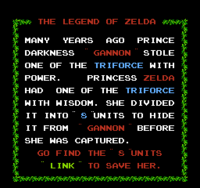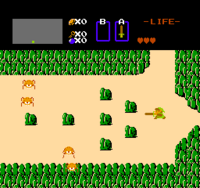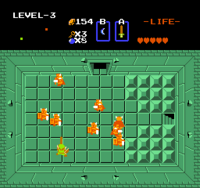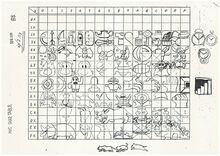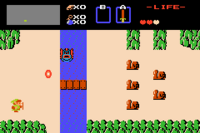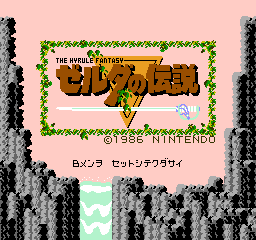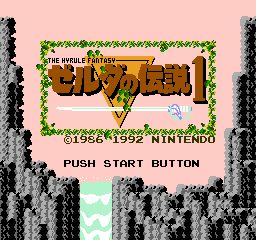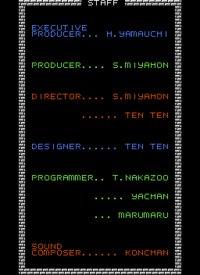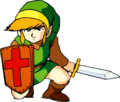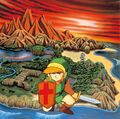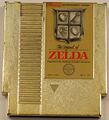Welcome to the new Mariopedia!
The Legend of Zelda
- This article is about the game. For information about the franchise, see The Legend of Zelda (franchise). For other uses, see The Legend of Zelda (disambiguation).
| The Legend of Zelda | |||||||||||||||

| |||||||||||||||
| Developer | Nintendo EAD | ||||||||||||||
| Publisher | Nintendo | ||||||||||||||
| Release date | Family Computer Disk System Nintendo Entertainment System Game Boy Advance Virtual Console (Wii) Nintendo 3DS Ambassador Program Virtual Console (Nintendo 3DS) Virtual Console (Wii U) Nintendo Switch Online | ||||||||||||||
| Genre | Action-adventure | ||||||||||||||
| Rating(s) |
| ||||||||||||||
| Media | NES:
FDS:
Floppy disk Wii: Wii U: Nintendo Switch: Game Boy Advance: Nintendo 3DS: NES Classic Edition:
Built-in
| ||||||||||||||
| Input | NES:
Wii: Wii U: Nintendo Switch: Game Boy Advance: Nintendo 3DS: NES Classic Edition:
| ||||||||||||||
The Legend of Zelda is the first and titular video game in The Legend of Zelda series. It was developed by Nintendo EAD and published by Nintendo. The game was first released in Japan in 1986, as a launch title for the Family Computer Disk System. A year later, in 1987, the game saw an overseas release on the Nintendo Entertainment System, and the game was contained within a gold cartridge. The Legend of Zelda is the first home console title with an internal battery for saving game data.[3]
At its time of release, The Legend of Zelda was noted for its expansive, nonlinear open world gameplay. It would eventually be regarded as one of the greatest and most influential video games of all time, laying the groundwork for the nonlinear RPG genre. A vastly different sequel for the same system, Zelda II: The Adventure of Link, was first released in Japan less than a year later. The Legend of Zelda would eventually spawn more successive titles and spin-offs and become one of Nintendo's most popular franchises.
Plot
The story of The Legend of Zelda is described in the instruction booklet and in the short prologue after the title screen.
During an age of chaos, a small kingdom of Hyrule is invaded by an army led by Ganon, who steal the Triforce of Power. Ganon (initially spelled as "Gannon" in-game, which is changed in later revisions), nicknamed the "Prince of Darkness", sought parts of the Triforce to rule over the world with fear and darkness. Fearing his rule, Princess Zelda split the Triforce of Wisdom into eight fragments and hid them around the kingdom. She then commanded her trustworthy nursemaid, Impa, to find someone with the courage to fight Ganon and his forces. Ganon finds out about her plan, so he angrily imprisons Zelda and sends his minions to search for Impa.
Impa fled from Ganon's troops, through forests and mountains. Sometime during her escape, Impa loses all of her energy and gets cornered by Ganon's troops. She is saved by a young hero named Link, whom she retells the whole story of Zelda and Ganon to. Link decides to go on a journey to rescue Zelda and recover each fragment of the Triforce of Wisdom, which he can use to confront Ganon.
During the course of the tale, Link locates and braves the eight underworld labyrinths, each containing a guardian monster, and retrieves a fragment from each one. With the completed Triforce of Wisdom, Link is able to infiltrate Ganon's hideout in Death Mountain, where he confronts Ganon and destroys him with the Silver Arrow. Link recovers the Triforce of Power from Ganon's ashes, and he returns both the Triforce of Power and the Triforce of Wisdom to the rescued Princess Zelda, allowing peace to return into Hyrule.
If the Second Quest is completed, the ending screen concludes with End of "The Legend of Zelda 1", hinting at a sequel.
Gameplay
The Legend of Zelda is notable for incorporating elements from the action, adventure, and role-playing genres. From a top-down perspective, the player can move Link around the Overworld, a large outdoor map with various environments. Link starts his adventure only equipped with a small shield, but he can enter a nearby cave and obtain a sword from the old man. Throughout his adventure, Link is aided by several characters who give or sell equipment and clues to him; these characters are found in caves scattered throughout the land. Some are easily accessible, and others are hidden beneath obstacles such as rocks, trees, and waterfalls. The Overworld is divided into sections, and a few enemies spawn in nearly every part of the map. Link must either battle or avoid them as he searches for entrances to large dungeons.
There are nine dungeons, each consisting of a maze which is individually separated into rooms, which are connected by doors and secret passages. The paths are usually closed off, and can only be opened if Link defeats every enemy in the room, or by moving blocks around. There are some unique items that Link can obtain within the dungeon, such as a boomerang. A boss often appears inside a dungeon, and must be defeated by Link to recover a fragment of the Triforce of Wisdom.
The Legend of Zelda is also noted for its flexibility, so the player can decide on the order that they complete the dungeons. However, the dungeons steadily increase in difficulty by number, and a few dungeon entrances from the Overworld can only be entered by using items that are obtained in previous locations.
After completing the game a first time, the player unlocks a harder mode known as the Second Quest. It is essentially a harder version of the first mode, featuring entirely different dungeons, relocated items, and stronger enemies. The Overworld remains largely unchanged except for the relocation of the dungeon entrances.
Characters
Playable character
| Sprite | Name | Description |
|---|---|---|
| Link | The main protagonist and playable character of the game. He embarks on a journey to stop Ganon and his forces. |
Supporting characters
| Sprite | Name | Description |
|---|---|---|
| Fairy | A helpful magical creature that can restore Link's health by contact if dropped from an enemy, or through a heart-giving spell at fountains. | |
| Hungry Goriya | A guard in some dungeons that can be bribed with food. | |
| Impa | Although she does not appear in the game herself, Impa is mentioned in the instruction booklet, as Zelda's most trustworthy nursemaid, of whom Zelda sends out to find someone to take on Ganon and his forces, later found to be Link. | |
| Merchant | Various sellers of items found in various locations throughout the game, some hidden. | |
| Old man | Old men also have various roles. One in the beginning gives Link his sword. In dungeons, they look slightly different and give Link advice, and will have their torches shoot fireballs at Link if he attacks them. In the overworld, one gives Link a letter to give to an old woman. Other ones can be found operating gambling games. Certain hidden ones will demand Link pay them for destroying the door to their hiding spot, which is done automatically, except for two in a dungeon in the second quest, which will give Link the option to either pay with Rupies or permanent loss of a Container Heart. | |
| Old woman | Old women have various roles. One, if given a letter, will sell Link Water of Life. Other ones give advice if given a certain amount of money. | |
| Princess Zelda | Zelda is the princess of Hyrule, and has been kidnapped by Ganon prior to the game's events. She has also scattered the eight fragments of the Triforce of Wisdom around the map. She is rescued by Link at the end of the game. | |
| Secret Molblin | Hidden Molblins that give Link Rupies if he discovers their hiding places, telling him to keep it a secret. |
Enemies
Overworld enemies
| Sprite | Name | Description |
|---|---|---|
| Armos | Statues that come to life and run around when touched. | |
| Ghini | Ghosts that come out of gravestones when they are touched. | |
| Leever | Spinning, burrowing plants found in sandy areas. They come in red and blue. | |
| Lynel | Tough lion-like centaurs that can shoot sword beams. They are found in mountainous areas and come in red and blue. | |
| Molblin | Spear-throwing bulldog-like enemies found in forests. They come in orange and teal. | |
| Octorok | Simple octopus enemies that spit rocks, found throughout the overworld. They come in red and blue. | |
| Peahat | Flying flower enemies that can only be attacked when landing. | |
| Tektite | Hopping spiders that come in orange and blue. | |
| Zola | Territorial fish-people that spit fireballs before hiding back under the water. |
Small underworld enemies
| Sprite | Name | Description |
|---|---|---|
| Bubble | Floating, burning skulls that flash various colors. Touching them causes Link to be cursed into not being able to us his sword for a time. In the second quest, there are solid red ones that curse Link indefinitely, until he touches a solid blue one. | |
| Darknut | Knight enemies with blocking shields that must be attacked from the side. They come in orange and blue. | |
| Gel | Small slimes that move one tile at a time, and typically share their colors with the dungeon wall, though some are black to blend in in dark rooms. | |
| Gibdo | Mummies that can visibly carry items such as bombs and keys. | |
| Goriya | Boomerang-throwing canines that come in red and blue. | |
| Head of Gleeok | Gleeok's floating severed heads which can still breath fire. | |
| Keese | Bats that fly around the screen erratically. They are typically blue, though they appear black in some darker dungeons to blend in with unlit rooms. When a Vire is defeated, it splits into two red-colored ones which act the same. | |
| Like Like | A tube-shaped enemy that will eat Link if touched, irrevocably stealing his Magical Shield if he is carrying one. | |
| Mini-Digdogger | The result of Digdogger hearing the recorder, they are fast and hard-hitting, but not durable. | |
| Pols Voice | Durable rabbit ghosts that are weak to the Family Computer Disk System's microphone, and arrows in Western releases. They share Link's palette. | |
| Rope | Snakes that will charge at Link if they see him and are on the same x- or y-coordinate. There are also stronger ones flashing various colors in the second quest. | |
| Stalfos | Skeletons that walk slowly around dungeon rooms. In the second quest, they can shoot powerful sword beams. | |
| Vire | Hopping demons that split into two red Keeses upon defeat. | |
| Wall Master | Hands that emerge from walls, sending Link back to the dungeon's entrance room if they grab him. | |
| Wizzrobe | Powerful wizards that shoot magic. The orange ones slowly warp around the room between magic blasts, and the blue ones move forward constantly and can warp across the room rapidly to surprise or evade Link. | |
| Zol | Large slimes that split into two Gels upon defeat. Like Gels, their color is typically shared with the dungeon's own walls, but black in some darker ones. |
Large underworld enemies
These are usually signified with a roaring sound effect in their rooms and may be encountered as bosses or as enemies. Bosses are always found in the room directly before the goal and drop a Container Heart (or in Ganon's case, the Triforce of Power).
| Sprite | Name | Description | Level boss (1st quest) | Level enemy (1st quest) | Level boss (2nd quest) | Level enemy (2nd quest) |
|---|---|---|---|---|---|---|
| Aquamentus | A dragon-unicorn that can spit three fireballs at a time. The horn is the weak spot. | 1, 7 | none | 1 | 4, 8 | |
| Moldorms | Segmented worms that snake around the rooms in pairs. Their segments must be destroyed to defeat them. | none | 2, 7 | none | 1, 8 | |
| Dodongo | A tough-skinned creature resembling a Triceratops or a rhinoceros that can be defeated by either feeding it two bombs directly, or stunning it with a bomb and then hitting it with a sword. | 2 | none | none | 1, 4 | |
| Dodongo trio | Dodongos often appear with three at once. | none | 5, 7 | 3, 8 | 4, 8 | |
| Manhandla | A four-headed Piranha Plant that can move and shoot fireballs from each head. Each must be defeated individually to destroy the whole plant. | 3 | 4, 8 | none | 2, 5, 6, 7 | |
| Gleeok (two heads) | A double-headed dragon, both of which can shoot fireballs. After a head is defeated, it will turn red and start flying around, still able to shoot fire. Once all heads are detached, the creature will be defeated. | 4 | none | 2 | 6 | |
| Gleeok (three heads) | A stronger form of Gleeok. | none | 6 | 5 | none | |
| Gleeok (four heads) | The strongest form of Gleeok. | 8 | none | 7 | none | |
| Digdogger (one Mini-Digdogger) | A large sea urchin that shrivels up into a small, defeatable state when Link plays the recorder near it. | 5 | none | none | none | |
| Digdogger (three Mini-Digdoggers) | A Digdogger than splits into multiple smaller versions when Link plays the recorder. | none | 7 | 4 | 4, 8 | |
| Gohma (red) | A large, cycloptic, fire-shooting arthropod. Its eye is weak to arrows when it opens. | 6 | none | none | none | |
| Gohma (blue) | A stronger form of Gohma. | none | 8 | 6 | 5, 7 | |
| Lanmolas | Segmented centipedes that move erratically around the room in pairs. To defeat them, the various segments must be destroyed. They come in orange and blue, with both in a pair being the same color. | none | 9 | none | 9 | |
| Patra | A durable blue flying eye surrounded by circling smaller orange flying eyes it can manipulate in various ways. | none | 9 | none | 9 | |
| Ganon | The main antagonist, he warps around the room while invisible and shooting fire. After damaging him enough, he becomes visible to Silver Arrows, which will defeat him by turning him into dust. | 9 | none | 9 | none |
Obstacles
| Sprite | Name | Description |
|---|---|---|
| Rock | Simple boulders that fall from mountains to their bases. | |
| Stone Statue | Gargoyles that typically act as decoration, but in some cases shoot fireballs in Link's direction. | |
| Trap | Invincible spined mechanisms that slide quickly at Link when he crosses their x- or y-coordinates. |
Items
These are items that cannot be used from the sub screen:
| Sprite | Name | Description |
|---|---|---|
| Clock | Permanently freezes every enemy that is currently on screen. The effect wears off when Link moves to the next screen or room. | |
| Container Heart | Permanently boost Link's health. In the second quest, there are two instances in which they can be taken away, however. | |
| Heart | These items restore missing portions of Link's health. | |
| Rupy | Rupies are the currency used in game. Most Rupies flash between orange and blue. A solid blue Rupy, named 5 Rupies (or 5 Rupees), is at the value of five Rupies. They are called "Rupies" in-game, "rubies" in the manual, and "rupees" in the Tips & Tricks guide and the 2003 version. | |
| Triforce fragment | The eight units of the Triforce of Wisdom, needed to access Death Mountain. | |
| Triforce with Power | The part of the Triforce Ganon has, obtained from his ashes after defeating him. |
These are items that can be used from the sub screen:
| Sprite | Name | Description |
|---|---|---|
| Food | Can be used to bait monsters, including the hungry Goriyas. | |
| Letter | Can be given to a little old lady, who will then sell Link both types of potions. | |
| Recorder | Can be used to warp using tornadoes, weaken Digdogger, and drain certain lakes. | |
| Water of Life | The Water of Life replenishes Link's health if used, but must be refilled to be used again. The blue variant, named Life Potion, has one use, and the red variant, named 2nd Potion, becomes a Life Potion when used. |
These are items and objects that help or allow Link to access different locations. They cannot be assigned from the sub screen:
| Sprite | Name | Description |
|---|---|---|
| Compass | Shows the location of the labyrinth's boss on the map. | |
| Key | Unlocks a single door, and can be used between dungeons. | |
| Magical Key | Unlocks an infinite amount of doors. | |
| Map | Shows the room layout of the dungeon it is in. | |
| Raft | Can be used to travel between docks across bodies of water. | |
| Stepladder | Can be used to cross holes or rivers in Link-sized spaces. |
Weapons
Weapons can be assigned to from the sub screen.
| Sprite | Name | Description |
|---|---|---|
| Arrow | Can be shot at enemies at the cost of a single Rupy per shot. They are the weakness of Pols Voices in the Western releases. | |
| Blue Candle | Can create a slow-moving fire that can be used to light up dark rooms, burn bushes, or attack certain enemies, but can only be used once at a time per map section/room visit. | |
| Bomb | Can be used to defeat enemies or find hidden doorways, which can be marked by a crack or indistinguishable from the wall. Link can hold eight at a time. | |
| Boomerang | Can be thrown to stun enemies. | |
| Bow | Can be used to shoot arrows. | |
| Magical Boomerang | Like the boomerang, but with a wider reach. | |
| Magical Rod | Can be used to shoot powerful magic blasts. | |
| Red Candle | It has the same function as the Blue Candle but can produce unlimited flames. | |
| Silver Arrow | Used to deal the final blow to Ganon. |
Equipment
Unlike weapons or items, these are automatically assigned to Link; some are later replaced:
| Sprite | Name | Description |
|---|---|---|
| Blue Ring | Boosts Link's defense and makes his clothing blue. | |
| Book of Magic | A book that can be used to boost the Magical Rod into creating fire. | |
| Magical Shield | Defends against strong projectiles like fireballs, but can be eaten by Like Likes. | |
| Magical Sword | The strongest sword. | |
| Power Bracelet | Allows Link to move rocks to find secrets. | |
| Red Ring | Boosts Link's defense and makes his clothing red. | |
| Shield | Link's small shield that can block weak projectiles, like Octorok's rocks and Molblin's spears. | |
| Sword | The weakest sword. | |
| White Sword | The medium sword. |
Locations
Overworld
The Overworld is the hub location of the game. Aside from labyrinths, some other locations appear from the overworld itself:
While technically not a location, Link can play the Money Making Game from a few of the caves.
Levels
Every level takes place in a labyrinth:
- Level-1: Eagle (Second Quest)
- Level-2: Moon (Second Quest)
- Level-3: Manji (Second Quest)
- Level-4: Snake (Second Quest)
- Level-5: Lizard (Second Quest)
- Level-6: Dragon (Second Quest)
- Level-7: Demon (Second Quest)
- Level-8: Lion (Second Quest)
- Level-9: Death Mountain (Second Quest)
Development
The Legend of Zelda was developed and directed by Shigeru Miyamoto and Takashi Tezuka. Miyamoto produced the game and Tezuka produced the script. The manual's backstory was written by Keiji Terui, whose writing was inspired by conflicts in medieval Europe and resulted in the legend of the Triforce. During development, the game was known as 「デス・マウンテン」 (Desu Maunten, Death Mountain).[4]
The Legend of Zelda began development in 1984, at the same time as Super Mario Bros., which had a largely similar development team. The ideas were separated between both games, for instance, how Super Mario Bros. had linear gameplay contrasting with The Legend of Zelda's open world exploration. According to Miyamoto, those in Japan were confused and had trouble finding their way through the multi-path dungeons, and in initial game designs, the player would start with the sword already in their inventory. Rather than merely simplifying matters for players, Miyamoto forced the player to listen to the old man who gives them the sword, and he encouraged interaction among people to share ideas on finding various hidden secrets, a new form of gaming communication. Many years later, this concept was used as the root of the Animal Crossing series.[5]
With The Legend of Zelda, Miyamoto wanted to flesh out the idea of a game "world" even further, giving players a "miniature garden that they can put inside their drawer." He drew his inspiration from his experiences as a boy around Kyoto, where he explored nearby fields, woods, and caves, always trying through Zelda titles to impart players some sense of that limitless wonder he felt through unknown exploration.[6]
Early concepts of the game involved technological elements, with microchips for the Triforce made of electronic circuits and a time-travelling protagonist. While the final game follows a traditional heroic fantasy setting, subsequent games in the series have incorporated some technology based concepts.[7]
The five music tracks were composed by Koji Kondo. The orchestral piece Boléro was originally planned as the title theme, but Kondo was forced to change it late in the development cycle after learning that the song's copyright had not yet expired. As a result, Kondo wrote a new arrangement of the overworld theme within one day, which has become an iconic motive echoing throughout continued entries of the series.[8]
Release
In February 1986, Nintendo released The Legend of Zelda as a launch title on the Family Computer add-on, the Family Computer Disk System peripheral. It made full use of the Disk Card media's advantages over traditional ROM cartridges, with an increased size of 128 kilobytes which would be expensive to produce on cartridge format.[6]
However, due to the disk space's limitations, all of the text was only sourced from the katakana alphabet. Players could save their progress by using rewritable disks rather than using a password system that many other games had. The Family Computer Disk System utilized an additional sound channel for certain sound effects, such as Link's sword beam at full health, the roars and growls of dungeon bosses, and those of defeated enemies. The sound effects had to be altered for the eventual cartridge release, which used the Family Computer's PCM channel.
When Nintendo published the game in North America, the packaging design featured a small portion of the box cut away to reveal the unique gold-colored cartridge. The cartridge made use of the Memory Management Controller chip (specifically the MMC1 model), which could use bank-switching to allow for larger games than had previously been possible.[9] This release was notable for being the first cartridge-based game to utilize battery-powered RAM that allowed players to save their progress.
From the success of magazines in Japan, Nintendo knew that game tips were a valued asset. Players enjoyed the bimonthly Nintendo Fun Club newsletter's crossword puzzles and jokes, but game secrets were most valued. The Fun Club drew kids in by offering tips for the more complicated games, especially Zelda, with its hidden rooms, secret keys and passageways.[10] The mailing list grew. By early 1988, there were over a million Fun Club members, which led Minoru Arakawa to start the Nintendo Power magazine.[10]
Reception and legacy
The Legend of Zelda was a best-selling title, having sold over 6.5 million copies.[11] The game placed first in the player's poll "Top 30" in Nintendo Power's first issue and continued to dominate the list into the early 1990s. The Legend of Zelda was also voted by Nintendo Power readers as the "Best Challenge" in the Nintendo Power Awards '88. In 2016 GamesRadar ranked it the third best NES game ever made. The staff praised its "mix of complexity, open world design, and timeless graphics".[12]
The Legend of Zelda is often featured in lists of games considered the greatest or most influential. It placed first in Game Informer's list of the "Top 100 Games of All Time" and "The Top 200 Games of All Time" (in 2001 and 2009 respectively), fifth in Electronic Gaming Monthly's 200th issue listing "The Greatest 200 Videogames of Their Time", seventh in Nintendo Power's list of the 200 Best Nintendo Games Ever and 77th in Official Nintendo Magazine's 100 greatest Nintendo games of all time. In 1997 the 32nd issue of Next Generation listed the North American release under their "Five Greatest Game Packages of All Time" list, citing the die-cut hole which revealed the gold cartridge, full color manual, and fold-out map.
In a review of the Wii Virtual Console rerelease Lucas M. Thomas from IGN praised the game's graphics, music, gameplay, and lasting appeal, while criticizing that the game can be too cryptic for new players. He stated that "The Legend of Zelda is a timeless adventure, worth playing through again and again.", while giving the game a nine out of ten.[13] Damien McFerran from Nintendo Life gave the NES version of the game an eight out of ten, stating that the game is "one of the finest 8-bit RPGs available".[14] In a negative review David Fisher from Game Shinny gave the game a six out of ten, praising the game's exploration, difficulty balance, and graphical presentation, while criticizing the game's boss variety, the map not telling the player where items are, the game's controls, stating that "In my own run I died about 5 times between the start of the game and the end of the first boss. This might suggest highlighting The Legend of Zelda (NES) as a game geared toward "hardcore" players, however, the deaths are not because of the game's inherent difficulty. Instead, the difficulty is a result of the faulty controls.", and the game's reliance on the manual.[15]
The Classic NES series port of The Legend of Zelda received a score of 84 on Metacritic.[16]
| Reviews | |||
|---|---|---|---|
| Release | Reviewer, Publication | Score | Comment |
| Nintendo Entertainment System, Wii, Nintendo 3DS | Lucas M. Thomas, IGN |
9/10 | "The Legend of Zelda's sequel, Zelda II: The Adventure of Link, will benefit even more from be played through the VC but that's a tale for another time. For now, experience the original. Revisit Link's first journey through the land of Hyrule, and see where the franchise first was formed. The Legend of Zelda is absolutely worth your 500 Wii Points, even if you already own it in other forms. For me, I think it's time to take another shot at the Second Quest - I wonder what Drew is up to these days?" |
| Nintendo Entertainment System | Damien McFerran, Nintendo Life |
8/10 | "This ranks as one of the finest 8-bit RPGs available. If you don't already own a copy of this (and you might do if you got the GBA version or you own the GameCube Zelda disc) you should download it right away!" |
| Nintendo Entertainment System | David Fisher, Game Skinny |
6/10 | "The Legend of Zelda despite having a number of failings is still a rather enjoyable game. It has a certain charm to it that time itself cannot take away. However, new players should certainly be aware of its failings. The controls have not aged well at all, and without a guide newcomers should be ready to wander the Kingdom of Hyrule aimlessly for a long time before stumbling upon their first dungeon. That said, the game is certainly playable, and is a worthwhile game to pick up if you are willing to invest the time.
As such, I give The Legend of Zelda (NES) a 6 out of 10 for being a game that only a dedicated fan of the series - or of adventure games - can truly bring themselves to play anymore." |
| Aggregators | |||
| Compiler | Platform / Score | ||
| Metacritic | 84 | ||
Alternate versions and re-releases
- 1986 - Original release on the Family Computer Disk System (Japan)
- 1987 - Original release on the Nintendo Entertainment System (North America/Europe/Australia)
- 1992 - Re-released on the NES as part of the "Classic Series", featuring a gray cartridge.
- 1994 - Back-ported to a Family Computer cartridge and renamed to The Hyrule Fantasy: The Legend of Zelda 1 (Japan)
- 1995/1996 - A remake, titled BS Zelda no Densetsu, was broadcast for the Satellaview add-on of the Super Nintendo in four episodic, weekly installments.
- 2001 - The original game is unlockable in Animal Crossing for the Nintendo GameCube. It is one of the "Forbidden Four," and cannot be accessed in-game without a cheating device.
- 2003 - The original game is one of the four full games on The Legend of Zelda: Collector's Edition
- 2004 - Ported to the Game Boy Advance as part of the Classic NES Series
- 2006 - Ported as one of the first Virtual Console titles on the Wii
- 2008 - Available as a Masterpiece in Super Smash Bros. Brawl
- 2011/2012 - Ported to select Nintendo 3DS units as an Ambassador Program title, and later became more widely available with a Virtual Console release in 2012 (December 2011 in Japan).
- 2013 - Ported to the Wii U as a downloadable Virtual Console title
- 2014 - Also appears as a Masterpiece on Super Smash Bros. for Wii U
- 2016 - Released as one of the 30 games included on the NES Classic Edition and its Japanese counterpart, Nintendo Classic Mini: Family Computer.
- 2018 - Included as a playable title on the Nintendo Switch Online service. A "special save data" version was released a month later, allowing the player to start the game with more items and Rupies.
- 2021 - Included on Game & Watch: The Legend of Zelda as a playable title
Version differences
There are four versions of The Legend of Zelda's original release: the Family Computer Disk System, the PRG0 and PRG1 revisions, and the Family Computer re-release. The PRG1 revision is the Classic Series re-release,[17] and the PRG0 and PRG1 respectively have a product ID of NES-ZL-USA and NES-ZL-USA-1. The Nintendo Entertainment System release features many audio differences from the Family Computer Disk System version, to accommodate for the NES's inferior sound channel, and also includes a couple of minor differences from the original.
Starting with 2003, when The Legend of Zelda was included on The Legend of Zelda: Collector's Edition, many translation errors were fixed, most notably from the title screen intro. This version was reused in subsequent ports, except for the Virtual Console release on 3DS, which is based on the PRG1 version. The 2003 release's title screen was updated to include 2003 (or 2004 in the Classic NES Series re-release) as a copyright year. In Japan, the Collector's Edition version was released in 2004, and thus the title screen's copyright year was also updated to 2004. This version is based on the first Family Computer Disk System, but retains the rewritten intro from. Similarly, the Japanese 3DS Virtual Console opted to use the original translation.
There are a couple of other notable differences:
- The Bible was renamed to the Book of Magic from the introduction in international releases. This was done in order to comply with Nintendo of America's censorship policies against adding religious content in-game. The Family Computer cartridge re-release reads "Book of Magic" text but the katakana text still reads Bible.
- In the Family Computer Disk System and Family Computer versions, one way to defeat a Pols Voice is to yell into the Family Computer's built-in microphone. Since the NES hardware does not have this feature, Link can instead defeat a Pols Voice by firing Arrows at it.
- In the NES release, the Zola sprites changed to have a black outline surrounding them, which gives them further on-screen visibility.
- The NES release features the thicker, common font present in many NES games.
- In the PRG1 NES version, the save option screen warns users on how to prevent losing their save data. While this message was removed from the hidden Animal Crossing version, the text layout was left unchanged.
- The Family Computer Disk System version has a smoother screen transitional effect than the NES and Family Computer cartridge releases.
- The PRG1 version of the NES release adds a trademark symbol to the title screen.
- The Family Computer cartridge re-release was updated to include the number "1" in its title. This change is also reflected on the title screen.
- In Japan's 2004 reissue, the copyright info and "Press Start" message reuse the original Family Computer Disk System font.
Staff
Everyone except the producer, Hiroshi Yamauchi, is listed under a pseudonym during the end credits.
Executive producer:
- Hiroshi Yamauchi
Producer:
Directors:
- Shigeru Miyamoto
- Takashi Tezuka
Designer:
- Takashi Tezuka
Programmers:
- Toshihigo Nakago
- Yasunari Soejima
- I. Marui
Sound composer:
Connections to the Mario franchise
The Legend of Zelda has a couple of connections to the Mario franchise:
- The game was developed concurrently alongside Super Mario Bros. by a very similar group of developers in Nintendo. The ideas were sorted between the two games, with Super Mario Bros. receiving the linear ideas and The Legend of Zelda receiving the open-world ideas.
- In the Japanese manual, Manhandla is stated to be a giant Piranha Plant.
- The recorder reappears in Super Mario Bros. 3, in which it is titled the Magic Whistle.
Gallery
- For this subject's image gallery, see The Legend of Zelda/gallery.
Names in other languages
| Language | Name | Meaning |
|---|---|---|
| Japanese | ゼルダの伝説 Zeruda no Densetsu ゼルダの伝説1 Zeruda no Densetsu 1 |
Legend of Zelda (subtitled "The Hyrule Fantasy" on the logo) The Legend of Zelda 1 (Family Computer 1994 re-release) |
References
- ^ NES Games
- ^ Super Smash Bros. for Wii U Masterpieces
- ^ The Legend of Zelda Review - GameSpot
- ^ December 1, 1998. 照井啓司さんのコメントコーナー. Retrieved September 16, 2020.
- ^ Game Developers Conference 2007
- ^ a b The History of Zelda - GameSpot (Wayback Machine)
- ^ Gamekult interview with Shigeru Miyamoto
- ^ Zelda Exposed by 1up.com (Wayback Machine)
- ^ Nintendo Power Volume 20, page 30.
- ^ a b Sheff, David. Game Over. Page 178.
- ^ The Magic Box: International Video game News
- ^ http://www.gamesradar.com/best-nes-games-all-time/
- ^ https://ca.ign.com/articles/2007/02/15/the-legend-of-zelda-vc-review
- ^ http://www.nintendolife.com/reviews/vc/legend_of_zelda_nes
- ^ https://www.gameskinny.com/6rfbj/rewind-review-the-legend-of-zelda-nes
- ^ https://www.metacritic.com/game/game-boy-advance/classic-nes-series-the-legend-of-zelda
- ^ The Legend of Zelda – Release Details - GameFAQs
- The Legend of Zelda (game)
- The Legend of Zelda series
- Games
- Family Computer Disk System games
- Nintendo Entertainment System games
- Game Boy Advance games
- Virtual Console games
- Action-adventure games
- 1986 games
- 1987 games
- 2004 games
- 2011 games
- Nintendo 3DS Ambassador Program games
- Amiibo tap: Nintendo's Greatest Bits
